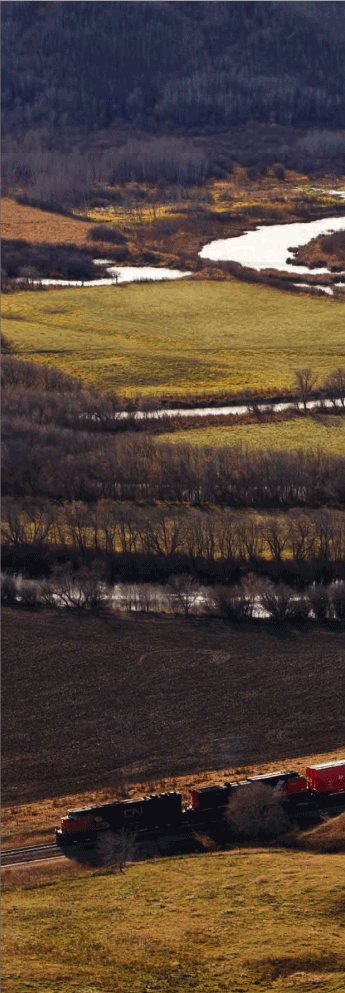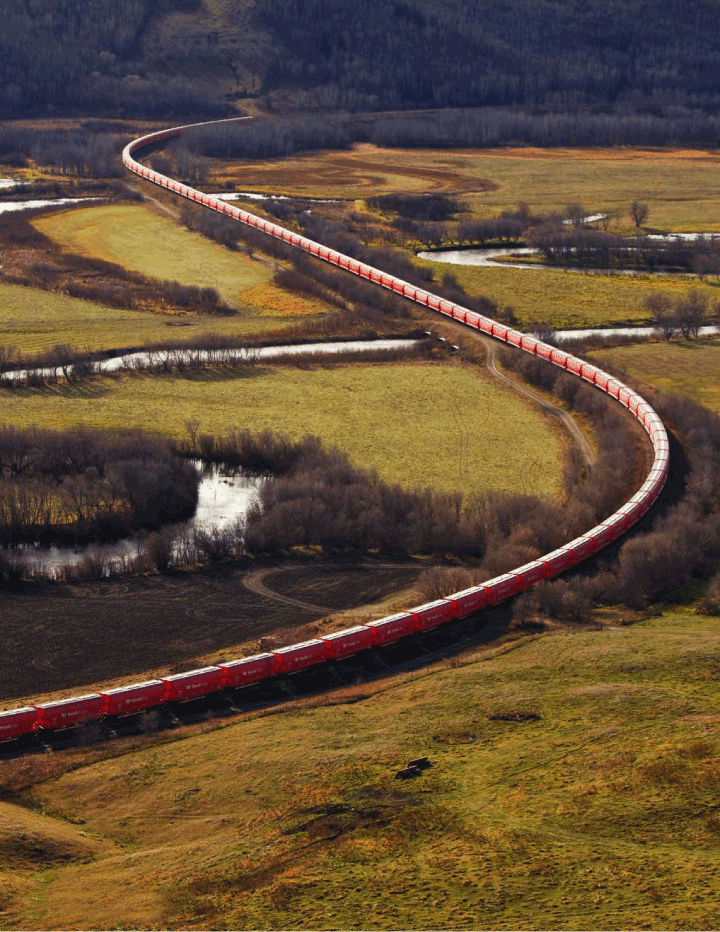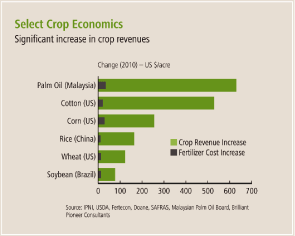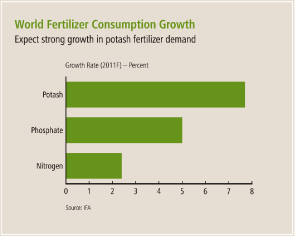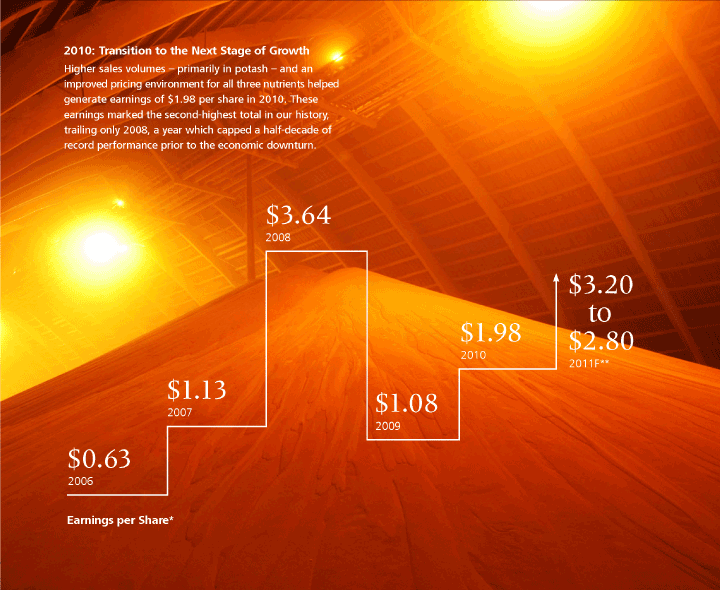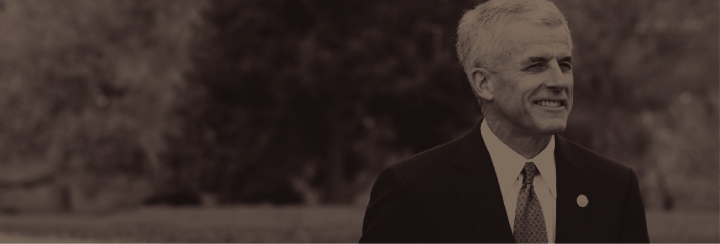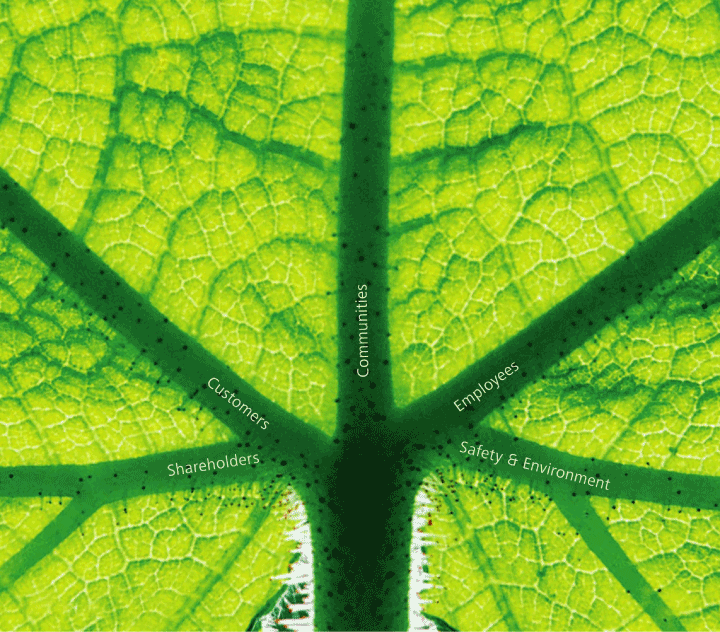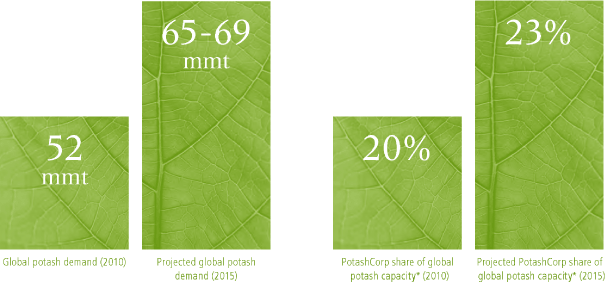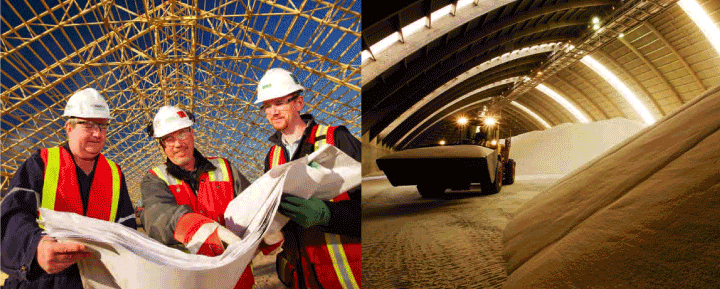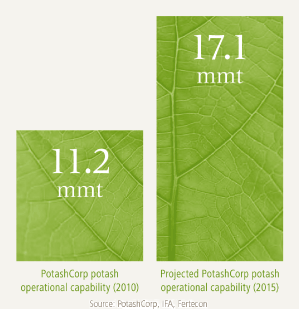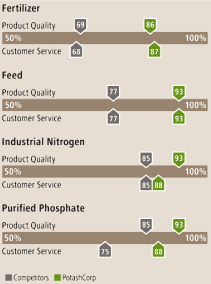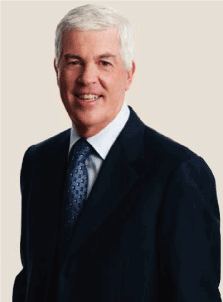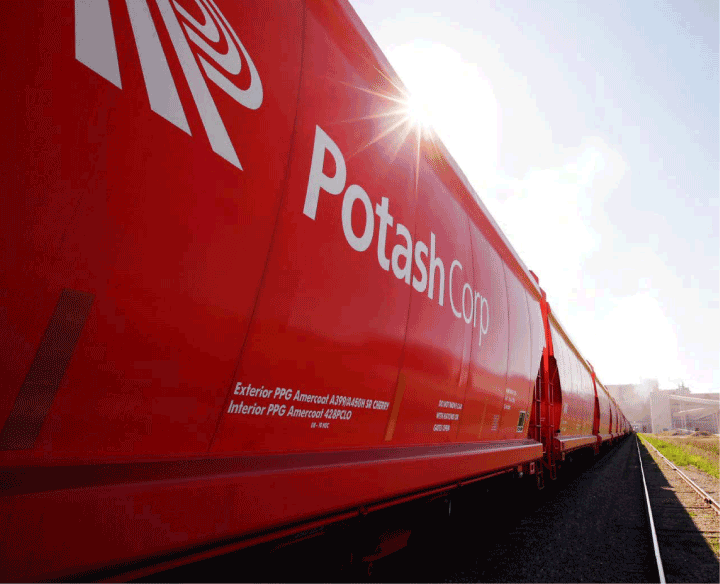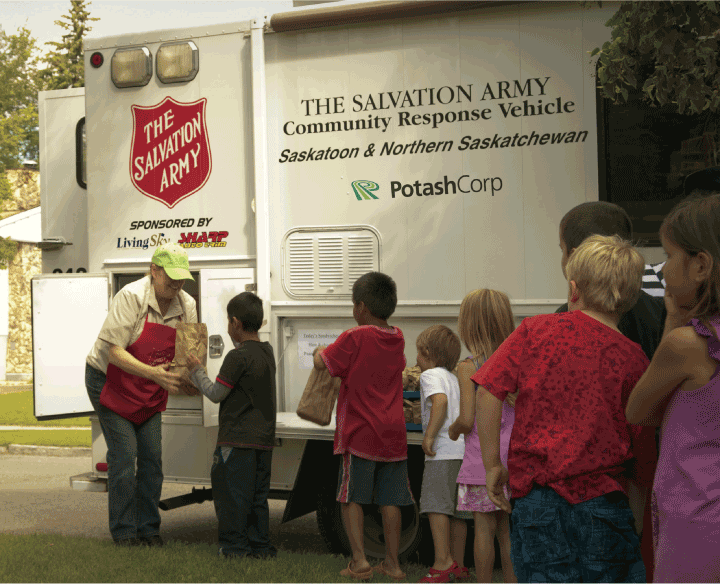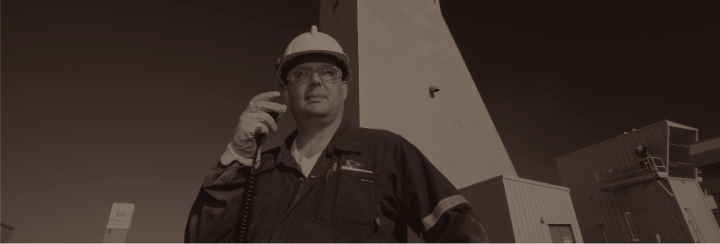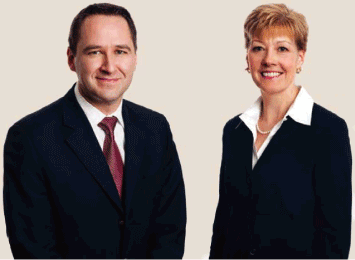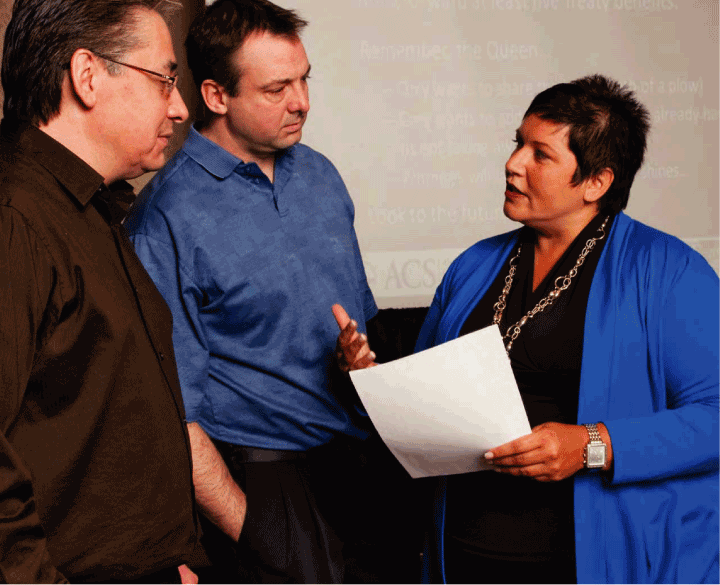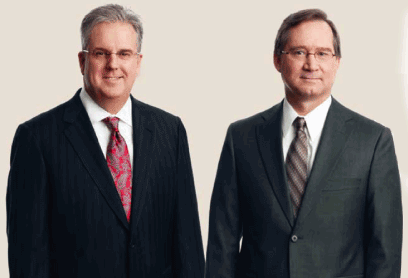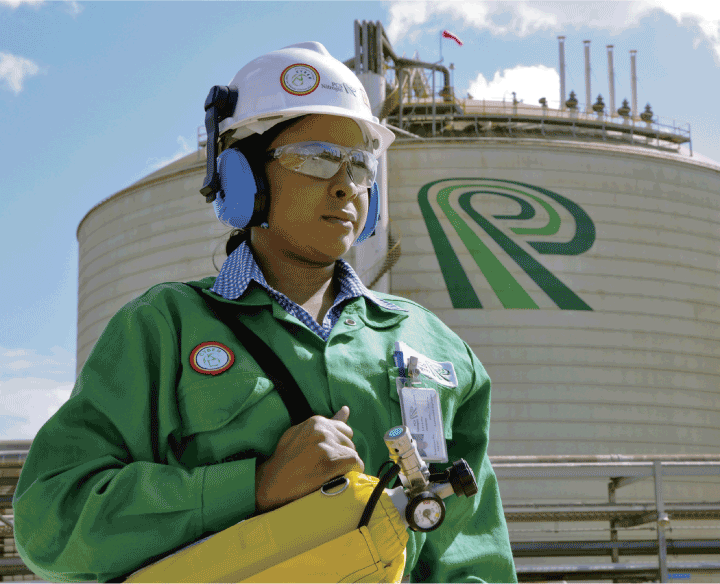Exhibit 99(b)
| | | | | |
| | | The Next Stage of Growth | | |
| | | 2010 Summary Accountability Report | | |
The Next Stage of Growth
Meeting the growing global demand for food is an ongoing challenge — one that continues to drive our vision and bring unprecedented opportunities for our company. In 2010, as the world refocused on the need to increase food production, the value of our crop nutrient products again became clear, marking the beginning of our next stage of growth.
To meet the challenges and seize the opportunities that come with being part of the world’s food solution, we need a clear path to long-term, sustainable growth. This path must be defined by our goals and marked by accountability for our actions and performance.
The progress measured by this Summary Accountability Report reflects the focus of all our people — from the Board of Directors and management team to our more than 5,400 employees — as we pursue our vision and goals.
Learn more online:
PotashCorp2010AR.com watch for Keywords to guide you
Financial data in this report are stated in US dollars unless otherwise noted.
Now available
Financial ReviewAnnual Report
A comprehensive guide to our 2010 financial performance, strategies, risks and outlook
Now available
Summary Accountability Report
A snapshot of our progress toward achieving our five key organizational goals
Spring 2011
Online Sustainability Report
Insights on our company’s environmental, social, economic and governance performance
Summer 2011
Overview of PotashCorp and Its Markets
Key market factors that influence our strategies and business prospects
Visit PotashCorp.comto view our four annual publications, plus our 10 K, Proxy Circular and more.
Financial data in this report are stated in US dollars unless otherwise noted.
| | | | | |
|
| Inside |
| 2 | | Our company |
| 4 | | Performance and outlook |
| 6 | | Message to stakeholders |
| 8 | | Create superior shareholder value |
| 14 | | Be the supplier of choice |
| 18 | | Build strong relationships with our communities |
| 22 | | Attract and retain top talent |
| 26 | | Achieve no harm to people/environment |
| 31 | | Board of Directors |
| 32 | | Senior management |
| 33 | | Company information and disclosure |
| |
|
| OUR COMPANY |
| |
PotashCorp is the world’s largest fertilizer company by capacity, producing the three primary crop nutrients — potash, phosphate and nitrogen. Our namesake — and the main focus of our business — is potash, which has been the major driver of our results. As the world’s leading producer, we are responsible for one-fifth of global potash capacity*. In addition, we hold strategic investments in other potash-related businesses in South America, the Middle East and Asia.
With top-tier resources and plans to expand our potash operations, we believe we have an unparalleled ability to respond to the rising needs of our customers and play a key role in meeting the world’s growing food requirements. |
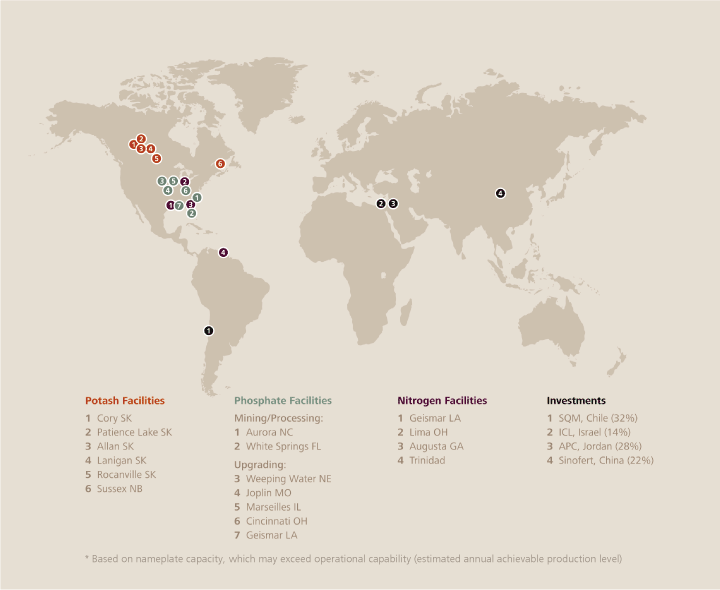
| Potash Facilities 1 Cory SK 2 Patience Lake SK 3 Allan SK 4 Lanigan SK 5 Rocanville SK 6 Sussex NB Phosphate Facilities Mining/Processing: 1 Aurora NC 2 White Springs FL Upgrading: 3 Weeping Water NE 4 Joplin MO 5 Marseilles IL 6 Cincinnati OH 7 Geismar LA Nitrogen Facilities 1 Geismar LA 2 Lima OH 3 Augusta GA 4 Trinidad Investments 1 SQM, Chile (32%) 2 ICL, Israel (14%) 3 APC, Jordan (28%) 4 Sinofert, China (22%) |
| * Based on nameplate capacity, which may exceed operational capability (estimated annual achievable production level) |
2
| | | | | |
|
| 20% | | 5% | | 2% |
| PotashCorp percentage | | PotashCorp percentage | | PotashCorp percentage |
| of world potash capacity* | | of world phosphate capacity | | of world nitrogen capacity |
| (#1 in the world) | | (#3 in the world) | | (#3 in the world) |
 | |  | |  | |
How Produced: | | How Produced: | | How Produced: | |
| Mined from evaporated sea deposits | | Mined from ancient sea fossils | | Synthesized from air using steam and natural gas or coal | |
| |
| |
How Used: | | How Used: | | How Used: | |
| |
Fertilizer: | | Fertilizer: | | Fertilizer: | |
| Improves root strength and disease resistance, enhances taste, color and texture of food | | Aids in photosynthesis, speeds crop maturity | | Builds proteins and enzymes, speeds plant growth | |
| |
Feed: | | Feed: | | Feed: | |
| Aids in animal growth and milk production | | Assists in muscle repair and skeletal development | | Essential to RNA, DNA and cell maturation | |
| |
Industrial: | | Industrial: | | Industrial: | |
| Used in food products, soaps, water softeners, de-icers and drilling muds | | Used in soft drinks, food additives and metal treatments | | Used in plastics, resins and adhesives | |
| | |
|
| * | | Based on nameplate capacity, which may exceed operational capability (estimated annual achievable production level) |
3
PERFORMANCE & OUTLOOK
2010
The ongoing challenge of meeting increases in global food demand became more pronounced as the year progressed, with prices for many crop commodities approaching record levels. Strong farm economics, combined with the need to address soil deficiencies that were exacerbated during the economic downturn, led to a rebound in demand for all three nutrients.
The recovery was most significant in potash as global shipments rose by nearly 80 percent from 2009 levels, to approximately 52 million tonnes.
Learn more:PotashCorp2010AR.com/factors
| Select Crop Economics Significant increase in crop revenues Change(2010)-US$/acre Palm Oil (Malaysia) Cotton (US) Corn (US) Rice (China)-CropRevenue |ncrease Wheat (US)B Fertilizer Cost Increase Soybean (Brazil) 0 100 200 300 400 500 600 700 Source: IPNI, USDA, Fertecon, Doane, SAFRAS, Malaysian Palm Oil Board, Brilliant Pioneer Consultants |
2011
With population rising and strong growth anticipated in developing economies, demand for food is expected to pressure global grain supplies. This creates a need to increase production and encourages farmers to invest in soil fertility.
For our key nutrient — potash — we believe the factors are in place for the next stage of growth in demand. With farmers around the world working to address soil nutrient imbalances and a supply chain that has yet to be restocked, we expect demand to increase to 55-60 million tonnes in 2011.
Learn more:PotashCorp2010AR.com/outlook
| World Fertilizer Consumption Growth Expect strong growth in potash fertilizer demand Growth Rate (2011F) — Percent Potash Phosphate Nitrogen 0 1 2 3 4 5 6 7 8 |
4
| | | | | |
|
| $1.8b | | $319m | | $510m |
| 2010 potash gross margin | | 2010 phosphate gross margin | | 2010 nitrogen gross margin |
| (2nd highest on record) | | (3rd highest on record) | | (3rd highest on record) |
| 2010: Transition to the Next Stage of Growth Higher sales volumes – primarily in potash – and an improved pricing environment for all three nutrients helped generate earnings of $1.98 per share in 2010. These earnings marked the second-highest total in our history, trailing only 2008, a year which capped a half-decade of record performance prior to the economic downturn. |
| | |
| * | | Adjusted for three-for-one stock split effective February 2011 |
| |
| ** | | As of January 27, 2011 |
5
MESSAGE TO OUR STAKEHOLDERS
William J. Doyle, President & CEO
“We continually challenge our people to find ways to make our stakeholder relationships stronger and our success more sustainable.”
Why Accountability Matters
A healthy farm — whether it is a cornfield in North America or a rice paddy in Asia — is the perfect model of a growing business. A farmer who understands what influences the growth of his or her crops, who plans ahead and nourishes the soil, can produce more over the long term ultimately generating a greater return on investment.
Our business must be cultivated in a similar way. To remain profitable and reward our long-term shareholders, we need to understand, anticipate and support the needs of all our stakeholders, creating sustainable value as we grow. When we help our customers, employees and communities to prosper — and keep our people and environment free from harm — everyone associated with our business has the opportunity to thrive. Each goal discussed in this report was created with these collective benefits in mind.
We continually challenge our people to find ways to make our stakeholder relationships stronger and our success more sustainable. Believing that transparency is at the heart of a strong, growing company, we set goals and targets that challenge us to improve, report on our progress and hold ourselves accountable for performance.
It is an exciting time for our company. With a foundation built on strong stakeholder relationships, we are ready to deliver on PotashCorp’s promise and potential as we enter our next stage of growth.
William J. Doyle
President and Chief Executive Officer
February 22, 2011
6
GOALS
| • | | Create superior long-term shareholder value |
| |
| • | | Be the supplier of choice to the markets we serve |
| |
| • | | Build strong relationships with and improve the socioeconomic well-being of our communities |
| |
| • | | Attract and retain talented, motivated and productive employees who are committed to our long-term goals |
| |
| • | | Achieve no harm to people and no damage to the environment |
7
GOAL
Create superior long-term
shareholder value
2010 Performance
| | | |
| |
| |
TARGET
Exceed total shareholder return (TSR) performance for our sector* and the DAXglobal Agribusiness Index
ACHIEVEDl
Our TSR of 43 percent exceeded the 40 percent return of our sector* and the 20.6 percent of the DAXglobal Agribusiness Index
| | Improved global demand for fertilizer contributed to substantial earnings growth across all nutrient segments in 2010. As agricultural fundamentals improved and expectations for potash demand rose, PotashCorp — the world’s largest producer of potash, with the greatest ability to grow in operational capability over the next five years — benefited from increasing shareholder recognition of the company’s earnings potential. |
| |
| |
TARGET
Exceed cash flow return (CFR) on investment for our sector*
NOT ACHIEVED○
CFR was slightly below that of our sector*
| | We continue to execute a Potash First strategy as we believe it has the potential to create superior long-term shareholder value. Our CFR increased in 2010, reflecting the significant rebound in global fertilizer markets and our ongoing investments in potash expansion projects and offshore potash investments. |
| |
| |
TARGET
Remain in the top quartile of governance practices as measured by predetermined external reviews
ACHIEVEDl
We ranked in the top quartile in all predetermined reviews
| | Our governance practices grow from our core values. By listening to and being accountable to our shareholders, we build trust and support, which enhances our ability to execute our strategies. |
| |
| | |
| * | | Sector: Weighted average (based on market capitalization) for Agrium, APC, CF Industries, ICL, Intrepid, K+S, Mosaic, SQM, Uralkali and Yara for most recent four fiscal quarters available. |
PotashCorp uses cash flow and cash flow return as supplemental measures to evaluate the performance of our assets in terms of the cash flow they have generated. Calculated on the total cost basis of the company’s assets rather than on the depreciated value, these measures reflect cash returned on the total investment outlay. We believe these measures are one of the best predictors of the ability to create long-term shareholder value. As such, management believes this information to be useful to investors.
Keyword:Shareholders
8
| | | | | |
|
| 2nd | | $2.6b | | 43% |
| Highest earnings per share (2010) | | Gross margin (2010) | | Total shareholder return (2010) |
Why this goal matters
Building long-term shareholder value is fundamental to the success of any business, since investors provide capital to operate. To earn shareholders’ ongoing support, we need to deliver greater long-term returns than our peers while continuously building trust and support through sound governance practices and ethical behavior.
Strong financial performance creates value for all our stakeholders: It enables us to maintain employment and create new jobs, support our communities and invest in the people and assets that will serve the long-term needs of our customers.
We strive to manage our business with patience and prudence. We follow proven strategies, communicating with clarity and transparency the details of our goals, decisions and performance.
Our approach to meeting this goal
| • | | Enhance our competitive strengths by investing in the people and resources needed to meet our organizational goals |
| |
| • | | Devise and execute strategies that generate future earnings growth and reduce volatility in earnings across all business segments |
| |
| • | | Leverage our world-class assets and experience to deliver superior returns for shareholders through the strategic use of capital |
| |
| • | | Develop and implement governance practices that minimize risk, maximize management performance and ensure we operate with integrity and transparency |
Wayne Brownlee
Executive Vice President and Chief Financial Officer
On shareholder value and thinking long-term
| Q | | How is shareholder value connected to other company goals? |
| | | Our goal is to create superior value for our shareholders, but we can only achieve and protect that if we also create value for our other stakeholders. |
| |
| | | Everything we do is integrated. We can’t maximize shareholder value if we don’t invest in our employees’ development and their safety. If we don’t reward them properly, they’re not likely to be engaged in their work or motivated to make the company the best it can be. It’s the same with customers and communities. The more we support our customers’ success, the more they’ll grow and contribute to our bottom line. This also applies to our communities. If we don’t earn their trust and support by being accountable, we can’t expect to have success. |
9
The Next Stage of Growth
is built on long-term resources and strategies
| Q | | What is the biggest risk you see to building long-term shareholder value? |
| | | One of the risks relates to the time period in which a company is trying to generate value. Taking shortcuts to create value for the current quarter at the expense of the returns of that year, or five years down the road, diminishes the long-term value of your company. |
| |
| | | We have to remind ourselves sometimes that operating our business is like a marathon, not a sprint. If we don’t achieve immediate results but set the company up to deliver greater value over time, then that is the right approach. |
| |
| | | Our strategies are based on a long-term game plan. That means we know what to do when running uphill, as in 2009. We also know how to execute when we hit a stretch that lets us build some momentum. We believe that’s where we are right now and we know what we need to do to maximize performance and stay on track for the future. |
| | | |
| | 2010 Key Developments | |
| | | |
| | Achieved second-highest total company earnings per share and gross margin | |
| | | |
| | Spent $1.4 billion on potash expansion and debottlenecking projects | |
| | | |
| | Reinvested $2 billion in our company through a share repurchase program | |
| | | |
| | Increased our ownership interest in Israel Chemicals Ltd. to 14 percent by purchasing $420 million in common shares | |
| | | |
| | Received four awards from the Canadian Institute of Chartered Accountants for excellence in fnancial, sustainability and electronic disclosure | |
10
The value of listening Recognizing that listening is one of the most effective ways to build strong relationships and improve performance, PotashCorp launched an online survey in 2010 to elicit feedback on its executive compensation practices. The survey was accompanied by online videos featuring the Board Chair and the Compensation Committee Chair discussing the company’s compensation philosophy and approach. As part of an ongoing effort to give shareholders a voice, PotashCorp also provides them with a binding vote on performance options and an advisory vote on executive compensation. View survey results:PotashCorp2010AR.com/survey |
| Q | | How do your core values impact shareholder value? |
| | | By living our core values, we help build trust and credibility for PotashCorp. Our reputation is one of our most important assets, and every action we take must uphold and reaffirm that reputation. |
| |
| | | Integrity is a cornerstone of our company. Holding ourselves to the highest standard of business conduct means that we do what we say we’ll do. |
| |
| | | It’s also important to be as transparent as we can. We want to be clear about the outcomes we’re trying to generate and the risks associated with our business. We have to help investors appreciate that conditions in our industry are dynamic, and try to make sure they won’t be surprised. That requires true transparency. |
| |
| | | You can extend this thinking to all our core values — protecting our people and the environment, sharing what we learn, listening to stakeholders, striving for continuous improvement. In the end, it’s about building trust. I believe stakeholders will support you in good times and difficult ones if you have a solid plan, behave consistently and communicate openly. That’s what we’ve experienced in the past, and that’s how we build value for the company. |
| Q | | What is the most important thing shareholders should know about PotashCorp? |
| | | They should know that demand for our products is expected to grow — and so is our company. Our goal is to create superior long-term shareholder value, and we believe we have the resources and strategies to make that happen. |
| |
| | | How confident are we in our plans? We’re investing more than CDN $7 billion to roughly double our potash operational capability between 2005 and 2015. We know we’ll see some fluctuations in our business because demand doesn’t grow in a straight line. But when you look at the world’s population and economic trends, we think there is a lot of upside. |
| |
| | | Potash demand is expected to grow and we have a unique ability to meet that demand. We started our expansions nearly a decade ago. Our competitors will need to invest billions and spend years building new capacity to keep pace. We believe we have a big head start and a clear advantage for years to come. |
| |
| | | That doesn’t mean we can take our eye off the ball. We need to execute our strategies, especially when demand fluctuates. But we like our position, and we intend to deliver for our shareholders and other stakeholders. |
| |
| | | Full interview:PotashCorp2010AR.com/Brownlee |
11
Need + Advantages +
As populations rise and diets improve, the need to increase food production is critical.
Historical under-application of fertilizer — particularly potash — has limited crop yields in many developing countries, but strong farm economics and improved education are encouraging better fertility practices around the world.
Limited economically mineable deposits, multi-billion-dollar development costs and lead times of seven or more years for a greenfield mine make it difficult to become a player in potash.
With one-fifth of the world’s capacity* and strategic investments in other offshore potash companies, we believe we have more opportunity to benefit from growth in world demand than any other producer.
Keyword:Our Business
| | |
|
| * | | Based on nameplate capacity, which may exceed operational capability (estimated annual achievable production level) |
12
Strategy =
We follow a Potash First strategy because of our advantages and opportunities in this key nutrient. Our resources and expertise enable us to expand our existing potash capacity more quickly and cost-effectively than greenfield development, and we have moved aggressively on our expansion plans.
As we expand our facilities, we become uniquely positioned to capture new demand.
Leverage
As global demand for potash grows and our sales and production increase, they create an environment in which we can demonstrate our unique potash earnings potential:
Prices
Pressure on global potash supply creates the potential for higher prices
Volumes
Nearly doubling our 2005 operational capability by 2015, we will account for the largest portion of new global capacity
Cost savings
As volumes increase, per-tonne fixed costs decrease
Investments
Earnings potential and market value of equity investments also benefit from potash price appreciation and volume growth
Building Long-Term Value
13
GOAL
Be the supplier of choice
to the markets we serve
2010 Performance
TARGET
Outperform competitors on quality and service as measured by independent surveys
ACHIEVEDl
We outperformed our competitors in all quality and service categories
We continually focus on meeting the needs of our customers, starting with the criteria they have identified as most important: quality, customer service and reliability. Customer surveys show that we consistently outperform competitors in these areas and that our sales team stands out for its knowledge of our customers, products and industry.
Performance vs Competitors
| Performance vs Competitors Fertilizer Product Quality 6986 Customer Service 6 Feed Product Quality7793 Customer Service Industrial Nitrogen Product Quality8593 Customer Service Purified Phosphate Product Quality8593 Customer Service Competitors BPotashCorp |
Keyword:Customers
14
| | | | | | | | | |
| #1 | | 750 | | | 17.1 mmt |
| Customer ranking for PotashCorp’s | | New railcars added to company’s | | Expected potash operational capability |
| performance vs peers (2010) | | potash fleet (2010) | | (2015) |
Why this goal matters
By helping improve our customers’ opportunities for success, we strengthen our own ability to grow, to remain profitable for the long term and to serve the interests of all our stakeholders.
Recognizing the needs of our customers and making decisions to meet those needs enable us to become their supplier of choice. By continuing to deliver high-quality products on time and at competitive prices, we can maintain their trust and loyalty, improving our business performance.
Our approach to meeting this goal
| • | | Build our potash operational capability and invest in our transportation and distribution systems to meet long-term growth in global demand |
| |
| • | | Listen to customers to understand their concerns and better serve their needs |
| |
| • | | Establish standards for customer service and product quality that set us apart from our competitors |
| |
| • | | Adapt to changing market conditions and customer needs |
Stephen Dowdle
President, PCS Sales
On partnerships with customers
| Q | | In a commodity-related business, how do you become the “supplier of choice”? |
| |
| | | We have to always think creatively about how we bring value to customers and how we can enhance their success. We must bring together their goal of profitability and our goal of being the supplier they choose. That means a lot of planning and communication throughout our organization and with our customers. |
| |
| | | More than that, it’s really about being able to meet their needs both today and in the future. Reliability of supply, product quality and customer service are what buyers demand and what we, as a company, focus on most. |
15
The Next Stage of Growth
means we are investing in ways to better serve our customers
| Q | | How do you ensure you are staying aligned with customer needs? |
| |
| | | The most direct way is by listening to our customers — what concerns they have, what kind of demand they anticipate today and down the road, and so on. Then we focus on trying to do the right things by them. |
| |
| | | Each year, an independent party conducts a survey to gather feedback for us, and we study it for insights into how we can add value. One of the things customers talk about is the quality of our market information — it’s widely recognized in the industry as being among the best. We make that information accessible on our website and our customers tell us they value that a lot. |
| |
| | | We also encourage our sales people to attend meetings our customers have with farmers. When you’re speaking to a group of people, you want to be relevant to what’s going on in the marketplace, so these opportunities make sure everyone in our organization stays up-to-date. More than that, they give us a chance to hear from people on the front lines about what they need, and that helps ensure alignment. |
| |
| Q | | Given that Canpotex handles offshore marketing, can you be a supplier of choice to those markets? |
| |
| | | Our customers turn to Canpotex because they see us, and other members of this marketing organization, investing in potash capacity that will be very important to meet growing demand in the future. |
| |
| | | When customers see Canpotex putting dollars into improving potash delivery — building special railcars to handle potash, improving port infrastructure in Vancouver and Portland — they want to buy from this marketing agency. |
| |
| | | Canpotex is one of the very few organizations with the ability to grow with demand. It operates like we do — with a focus on customer service. We share the same values about being aligned with customers. |
| |
| | | Full interview:PotashCorp2010AR.com/Dowdle |
| | | |
| 2010 Key Developments | | |
| |
| Completed construction on first phase of potash expansion at Cory and made substantial progress on projects at Allan, New Brunswick and Rocanville | | Scored higher than competitors on customer surveys related to customer service, product quality and reliability of supply |
| |
| Continued to advance capital plans for new investment in transportation and distribution infrastructure | | Purchased 750 railcars for our domestic potash fleet to improve cycle time and increase delivery speed |
16
Keeping the train moving
Reliability and consistency of supply are critical to our customers and the farmers they serve. As their opportunities and challenges grow, we need to grow along with them, investing in the transportation and delivery systems that get customers the product they need, when they need it.
Recent improvements to rail yard efficiency, product loading speed and railcar capacity have combined to reduce cycle times — the period between loading a car and its return to our production facility after delivery — compared to historical levels. Since cycle times determine how quickly we can return to the customer with new product, these investments — along with our potash expansions and warehouse additions — allow us to get to the market faster and more efficiently.
New PotashCorp railcars at Lanigan loading product that may travel halfway around the world.
17
GOAL
Build strong relationships with and improve the
socioeconomic well-being of our communities
2010 Performance
| | | |
|
| |
TARGET
Achieve 4 (performing well) out of 5 on community leaders’ surveys
NOT ACHIEVED○
We scored 4 or better on all surveys with the exception of Saskatoon
| | We ask communities to assess our social and environmental responsibility, along with the degree of positive impact we have on the community. Our 2010 scores involved Rocanville (4.2), Marseilles (4.5), Geismar (4.3), Trinidad (4.1) and Saskatoon (3.9).
A low score (2.5) for a new question on Aboriginal relations contributed to the lowered performance in our Saskatoon survey. We are focused on improving our relationship with this community and will use the valuable feedback to improve our efforts.
|
| |
TARGET
Achieve a 10 percent increase in employee participation in the matching gift program and a 10 percent increase in matching gift donations from 2009 levels
PARTIALLY ACHIEVED◐
Employee participation and matching gift donations exceeded 2009 levels by 9 percent and 14 percent, respectively
| | Employees contributed more to our matching gift program in 2010 than in the previous two years. Our dollar-for-dollar company match, in addition to our employees’ generous donations, contributed a total of $2.4 million to those charitable programs that mattered most to our people.
|
| |
TARGET
Invest up to 1 percent of after-tax earnings (on a five-year rolling average) in communities and other philanthropic programs
ACHIEVED●
Our annual philanthropic donations were 1.3 percent of the five-year average of after-tax earnings | | Our community investments were $17.4 million in 2010. We continued to commit both money and time to important causes and organizations in the communities in which we operate.
For 2011, we have stepped up our commitment and raised this target to a pre-tax basis. |
Keyword:Communities
18
| | | | | | | |
|
| $17.4m | | 14% | | | 4.2 |
| PotashCorp’s community | | Increase in employee matching | | Average community |
| investment (2010) | | gift donations (2010) | | survey score out of 5 (2010) |
Why this goal matters
Our communities grant us the right to operate and they provide employees, suppliers and business partners who help us meet customer and shareholder expectations. To sustain and expand PotashCorp, we need to be a good neighbor — creating long-term, mutually beneficial relationships that build trust and goodwill.
Strong relationships help us understand what our neighbors need and enable us to invest our time and money in ways that align with their interests. When we build trust that we are a responsible corporate citizen, communities are more likely to support our plans to grow our operations. This enables us to invest with confidence in the future growth and development of our company.
Our approach to meeting this goal
| • | | Target investments in organizations and projects that bring long-term value to the community, through corporate grants, matching gifts, in-kind donations and employee volunteer time |
| |
| • | | Participate in outreach projects to educate communities on subjects ranging from fertilizer use to environmental impact and safety |
| |
| • | | Contribute to economic growth by creating jobs, purchasing locally and paying taxes |
| |
| • | | Conduct surveys and participate in meetings and discussions to measure perceptions of our performance and identify opportunities for improvement |
| | | |
| Denita Stann | | Garth Moore |
Vice President, Investor
and Public Relations | | President, PCS Potash |
| |
On being a good neighbor
| Q | | Why is it important to have good relationships with your communities? |
| |
| | | We have to remember that we’re here because communities grant us that right. Their support is vital for our well-being — it enables us to move forward with confidence on projects that will help us grow our business. Communities also provide the people and resources we need to run our company, so we rely on them greatly. It’s important to keep that perspective in mind. |
19
The Next Stage of Growth
is being built on strong relationships with business and community partners
| Q | | How do you approach your relationships with communities? |
| |
| | | We think companies make a conscious choice whether to be isolated from the community or a contributor to it. Our aim is to make a positive contribution — to be a good corporate citizen. |
| |
| | | We see our company as part of a neighborhood. Being a good neighbor means both sides benefit. A great example is the mining permit we secured in Aurora in 2009. Our company benefited by securing a long-term mining permit — which is difficult in today’s environment — in large part because the community stepped up and said, “Yes, this is a good company. They’re true to their word.” In turn, we have been able to continue to have a positive impact on the community. We try to be genuine in the way we contribute to create mutual benefit in our relationships with communities. |
| |
| Q | | How do you monitor and build your reputation within communities? |
| |
| | | Having a good reputation is invaluable to our company, and we work hard to ensure our behavior is consistent with our promises. A lot of this comes back to living by our core values — doing what we say we’ll do, prioritizing the safety of our people and the environment, being transparent, striving for continuous improvement, listening and sharing what we learn. |
| |
| | | One way we monitor perceptions of our performance is by surveying communities on a regular basis for feedback, and we take it seriously. Sometimes this leads to some of our most important initiatives. For example, our Model Farm in Trinidad grew out of feedback from a community survey. It has become an important asset to local farmers who want to understand modern agriculture practices, and we wouldn’t have thought of the idea without input from the community. |
| |
| | | It’s really important that we understand what people in our communities think and value, particularly as we expand our operations. We work hard at helping them understand what we’re trying to accomplish, and making sure that our goals and their goals are aligned. |
| |
| | | Full interview:PotashCorp2010AR.com/MooreStann |
| 2010 Key Developments |
| |
| Refined our community investment strategy to focus efforts on high-impact, strategic targets |
| |
| Established an Aboriginal engagement strategy focused on building strong relations with First Nations and Métis communities |
| |
| Developed a pilot program for Aboriginal awareness training for all Saskatchewan employees |
| |
| Opened the Resource Center of the Trinidad Model Farm, which provides ongoing training and support for farmers in Trinidad and Tobago |
20
Food for growth
Two of PotashCorp’s key community initiatives in 2010 brought our vision to help feed a hungry world closer to home. A matching gift donation of CDN $500,000 to the Friendship Inn — a Saskatoon, Saskatchewan soup kitchen that provides meals and support for more than 500 visitors daily — helped this essential organization build toward its CDN $3 million campaign goal. The money will be used to double its capacity.
PotashCorp also contributed to Food on the Move, a joint “meals on wheels” program with the Salvation Army that distributes thousands of healthy meals to children and teens.
A volunteer hands out nutritious meals to young people in Saskatoon.
21
GOAL
Attract and retain talented, motivated and productive
employees who are committed to our long-term goals
2010 Performance
| | | |
|
| |
TARGET
Achieve an average employee engagement score of at least 75 percent on the annual survey
NOT ACHIEVED○
The average employee engagement score was 73 percent
| | While the overall engagement scores decreased slightly, this year’s sample was more than double the size — and more diverse — than in 2009. In 2010, four of the eight sites surveyed in the two-year rotation exceeded the 75 percent engagement target.
Employees continue to give PotashCorp high marks for helping them understand how to do their jobs, for a commitment to quality and for customer service. Although employees rated internal communications lower compared to other survey areas, scores have improved at almost all sites since the last time the survey was administered.
|
| |
TARGET
Fill at least 75 percent of senior staff openings with internal candidates
ACHIEVED●
We filled 94 percent of our senior staff openings with internal candidates
| | We try to fill most senior positions internally because we believe it helps motivate our people, broadens their knowledge and provides continuity for our business. Over the past five years, PotashCorp has filled 81 percent of senior staff openings internally.
In 2010, we worked to improve our ability to identify key and high-potential talent by enhancing our succession planning process and by facilitating more interdisciplinary succession dialogue with executive management. |
| |
TARGET
Achieve an acceptance rate of 85 percent on all external staff-level employment offers made
ACHIEVED●
We had an acceptance rate of 86 percent for all external staff-level employment offers made | | This new target was achieved in 2010. While our acceptance rate is competitive, the number of declines reflects an ongoing tight labor market, particularly in Western Canada and within the engineering fields. |
Keyword:Employees
22
| | | | | | | | | |
|
| 15 | | 350 | | | 94% | |
Number of career fairs
attended across Canada (2010) | | Increase in number of
PotashCorp employees (2010) | | Senior staff openings filled
with internal candidates (2010) |
Why this goal matters
Our company’s long-lived assets and great need for technical expertise require a talented and motivated workforce to maintain our competitive advantage and reach our goals.
It is even more critical that we secure quality talent as our potash expansions continue, competition for qualified candidates rises and our more experienced employees near retirement.
By finding, supporting and rewarding the people who are best able to meet the unique challenges of our business, we build a workforce that can execute our strategies and deliver strong results.
Our approach to meeting this goal
| • | | Work proactively to understand and address future employment needs to ensure we have the quality personnel to meet expansion requirements and retirement expectations |
| |
| • | | Hire candidates who want to develop with the company |
| |
| • | | Target key growth positions, looking for candidates with the skills and traits that are likely to result in long-term, productive employment |
| |
| • | | Offer competitive compensation and benefits, including incentives that align employee performance and motivation with corporate goals |
| |
| • | | Fill most management positions internally; enable employees to move among departments and facilities to improve skills and maximize natural aptitudes and talents |
| |
| • | | Survey employees to learn how we can improve our culture and employee engagement |
| | | |
|
| Lee Knafelc | | Jane Irwin |
newly appointed | | recently retired |
Vice President, Human Resources | | Senior Vice President, |
and Administration | | Administration |
| |
On building a strong workforce
| Q | | Why is it important to attract and retain motivated employees? |
| |
| | | Our employees are vital to our success. That’s true of all businesses, but it’s especially important in a natural resource company like ours, with tremendously valuable assets that must be managed over decades by highly skilled workers. The expertise we need is hard to come by, so having a committed, stable workforce and a strong management team which can grow together over time gives us a huge competitive advantage. |
23
The Next Stage of Growth
means more career opportunities for new and current employees
| Q | | How do you build a committed workforce? |
| |
| | | We begin with a clear employee value proposition and an understanding of the skills and traits we need from the people we hire. It’s really important that prospective employees know what the company is about before they join us, so they can understand how they fit in with what we’re trying to do. |
| |
| | | We also need competitive compensation and benefit programs. We have to work hard to be the employer of choice in our communities and to attract the best talent. |
| |
| | | Once we have people on board, we have to invest in training to help them advance their skills and grow within the company. We’ve been consistent for many years at hitting our annual target of filling 75 percent of our senior staff-level positions internally. By offering those kinds of opportunities, we can find and retain people who are as committed to us as we are to them. |
| |
| Q | | What are some of the most important advances you made on this goal in 2010? |
| |
| | | Leadership training was one of the key areas focused on in 2010. We have a lot of experienced and loyal employees who have been tremendous assets. But as the baby boomers move through our workforce, we’ll be faced with many retirements in the coming decade. |
| |
| | | We took an important step toward training the next generation of leaders by developing company-wide leadership core competencies. Then we started working with local universities and consultants to develop and enhance training programs that align with those competencies. |
| |
| | | We believe that keeping our people engaged, challenged and motivated is important to building a strong and loyal workforce. We saw evidence of that in the way our people handled themselves in the midst of a hostile takeover attempt — in a time of great uncertainty, they retained their focus on safety and productivity. Having people like that is extremely valuable to the company, something that makes us proud. |
| |
| | | Full interview:PotashCorp2010AR.com/KnafelcIrwin |
| 2010 Key Developments |
| |
| Developed an Aboriginal engagement strategy to help build relationships with Saskatchewan First Nations and Métis communities — an important source of future employees |
| |
| Provided $365,000 in tuition reimbursements, scholarships and bursaries |
| |
| Created a list of leadership core competencies, which will be used to develop programs to enhance the skills of the company’s next generation of leaders |
| |
| Hired 16 past summer students/interns for permanent positions |
24
Building bridges with First Nations and Métis communities
As one of the fastest growing demographic sectors of Saskatchewan’s population, the Aboriginal community is a vital part of the province’s future workforce. Recognizing the importance of building long-term, mutually beneficial relationships with First Nations and Métis people, PotashCorp established an Aboriginal engagement strategy in 2010.
This effort is led by our Director of Aboriginal Strategy, Leanne Bellegarde, a First Nations lawyer and former Saskatoon Police Commission chair. The strategy is designed to raise internal awareness on Aboriginal issues, to make the company more accessible and attractive as an employer and to help First Nations and Métis communities develop businesses to provide ongoing support for our operations.
Leanne Bellegarde discusses details with consultants Winston McLean (left) and John Lagimodiere, who are designing our Aboriginal awareness training program.
25
GOAL
Achieve no harm to people and
no damage to the environment
2010 Performance
Safety
| | | |
|
TARGET
Reduce total site* severity injury rate** by 35 percent from 2008 levels by the end of 2012 | | We achieved record performance in reducing the number of injuries, particularly serious injuries, by focusing on improved data analysis and reduction of exposure to situations in which injuries might occur. |
| | | |
ACHIEVED●
On track. We have achieved a 62 percent reduction from 2008 through 2010 | | |
| | | |
| |
| | | |
TARGET
Achieve zero life-altering injuries at our sites
ACHIEVED●
We had no life-altering injuries at our sites in 2010 | | To meet our goal and core value of no harm to people, we continue to focus on effective safety leadership at all levels in the organization. This has been instrumental in developing a culture of caring and strong personal safety ethics. |
| | | |
| |
| | | |
Environment | | |
| | | |
TARGET
Reduce company-wide greenhouse gas (GHG) emissions per tonne of product by 10 percent by the end of 2012, compared to 2007
ACHIEVED●
On track. We have plans in place to install GHG controls at one of the nitric acid plants in 2011 to meet our target in 2012 | | Our target to reduce greenhouse gas emissions by 10 percent is voluntary and not required by regulations. We will continue to review all proposed legislation to ensure compliance and monitor our operations for opportunities to reduce emissions. |
| | | |
| |
| | | |
TARGET
Reduce total reportable incidents (releases, permit excursions and spills) by 30 percent from our 2009 levels
NOT ACHIEVED○
We achieved a 9 percent reduction from 2009 levels | | We had 20 reportable incidents in 2010. Although this was our lowest annual total since we have been reporting these data, we achieved only a 9 percent reduction from 2009 levels. |
| | | |
| |
| | |
| * | | Total site includes PotashCorp employees, contract employees and all others on site. |
| |
| ** | | Severity injury rate is the total of lost-time injuries and modified work injuries for every 200,000 hours worked. |
Keyword:Safety/Environment
26
| | | | | |
|
| 0.15 | | 50% | | 9% |
| Record-low total site | | Decline in total site | | Reduction in reportable |
| lost-time injury rate (2010) | | severity injury rate (2010) | | environmental incidents (2010) |
Why this goal matters
Achieving no harm to people and no damage to the environment is so vital to our company that it is both an operational goal and a core value. Rooted in an underlying respect for people and the planet, we pursue this primarily for one reason: it is the right thing to do.
Nothing we accomplish as a company is more important than returning our people home safely and protecting our planet for generations to come. We strive to create a culture in which safety and environmental awareness is part of every decision we make and every activity we undertake. We believe every individual in our organization has a role in making PotashCorp safe and sustainable.
Our approach to meeting this goal
| • | | Foster a “culture of caring” in which safety awareness and environmental responsibility are ingrained in employees’ minds and habits |
| |
| • | | Work proactively using peer-based observations to reduce at-risk behaviors and identify hazards, while measuring the frequency and severity of workplace injuries to ensure accountability |
| |
| • | | Closely monitor the environmental impact of our operations, making improvements to equipment and processes to reduce our footprint |
| |
| • | | Align executive and employee compensation with corporate goals by embedding safety and environmental performance metrics prominently in bonus programs |
| | | |
|
| David Delaney | | John Hunt |
Executive Vice President
and Chief Operating Officer | | outgoing
Vice President, Safety,
Health and Environment |
On creating a caring culture
QWhat’s different about PotashCorp’s approach to protecting people and the environment?
We believe that good safety and environmental performance is about more than rules — it’s about creating a culture in which everyone takes personal responsibility for the people and places around them.
We try to develop a culture of caring. We watch and learn from one another. We hold each other accountable — not in a top-down manner, but with more than 5,400 employees who understand the importance of this goal. It’s like a wave gaining momentum; we see our people, suppliers and communities getting swept up in it. Some people think of safety and environmental responsibilities as obligations, and they are, but we also see them as opportunities to make PotashCorp a better company.
27
Trinidad reaches 9-million-hour milestone
Nothing we accomplish as a company is more important than returning our people home safely — and our nitrogen facility at Trinidad continues to excel at doing just that. In early 2010, the employees at this site achieved 9 million hours — ten years — without a lost-time accident.
Trinidad’s safety success stems from a collaborative approach based on personal observation and feedback. Guided by best practices developed by Behavioral Science Technology (BST) — processes that were launched at our Trinidad operation more than a decade ago — workers assess the behaviors of their peers, then work together to develop action plans that make tasks safer. Trinidad’s success is evidence of a “culture of caring” in action.
Laverne Jeremy, an Electrical and Instrumentation Engineer at our Trinidad nitrogen facility, by one of its huge ammonia storage tanks.
28
The Next Stage of Growth
can only be achieved by protecting our people and the environment
QWhere did the culture of caring start?
It has really evolved over the past six years. Take safety, for example, which has always been a priority. As we analyzed data and looked more closely at the root causes of incidents, we recognized that many injuries could have been avoided through more consistent behavior. So in 2006 we started working with BST to see what we could do better.
What we realized was that the behaviors that led to decreased performance grew out of beliefs and habits embedded in our corporate culture. This insight helped us see that to make lasting change at our company, we needed to shift attitudes and awareness — specifically, to encourage people to have a vested interest in each other’s well-being. To make that happen, we needed leaders who understood how to model this approach, which led us to improve our leadership training.
This is the way our safety and environment programs have evolved. They’re tied to our core value of continuous improvement — and they’re working. We know from surveys that our culture and our safety approach are more closely aligned than when we implemented the program.
QHow would you assess your progress in this goal in 2010?
Our recordable, lost-time and severity injury rates are all down substantially from 2009, which was a record-low year. We think this can be attributed to how deeply safety is rooted in our organization — how it’s become personal to everyone from leaders to front-line workers.
An interesting thing we’re seeing is more reports of near-misses. At first you might think that’s a problem, but, really, it’s an indication that the culture is working. It means people aren’t afraid to report a problem. It’s an early warning system and people are using it to improve safety.
From an environmental perspective, we are improving our performance in reducing GHG emissions, but we didn’t meet our target on reportable incidents. Over the last 10 years we’ve improved our release and permit excursions targets by 75 percent, and 2010 was a record-low year. It’s getting harder and harder to show more improvement, but that doesn’t mean it’s impossible, and we continue to focus on this.
Full interview:PotashCorp2010AR.com/DelaneyHunt
| | | |
| | 2010 Key Developments | |
| | | |
| | Achieved record-low incidence in key injury metrics: recordable releases, lost-time and severity injury rates | |
| | | |
| | Reached significant safety milestones at Allan, Aurora, Cincinnati, Geismar, Lima, Marseilles, Patience Lake and Trinidad | |
| | | |
| | Received an American Institute of Architects’ Distinguished Building Award for our Gold LEED-certified Marseilles Administration Building | |
29
New sulfuric acid plant adds production, reduces emissions
We seek to improve the value we create for all stakeholders through our use of capital. When our Aurora phosphate facility started up its new sulfuric acid plant in 2010, it increased production capacity of this feedstock by 25 percent compared to the two plants it replaced, eliminating the need to purchase sulfuric acid. Moreover, it substantially reduced Aurora’s environmental footprint.
Integrating advances in technology into the design made it possible to reduce the site’s sulfur dioxide emissions to half the standard set by the US Environmental Protection Agency. The plant’s new design also enables Aurora to use clean, high-pressure steam to produce electricity, reducing annual carbon dioxide emissions.
John Jordan, an operator at our Aurora facility, makes regular rounds checking the equipment.
30
Board of Directors
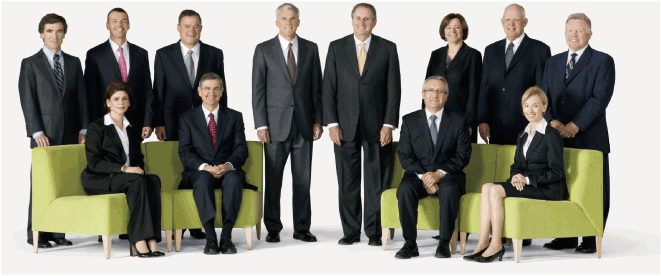
| | | | | |
|
Standing (L to R) | | | | Seated (L to R) |
| | | | | |
Jeffrey J. McCaigB,D | | Dallas J. Howe (Chair)A | | Elena Viyella de PalizaC |
| Calgary AB | | Calgary AB | | Dominican Republic |
| Chairman and CEO | | Owner and CEO of DSTC Ltd. | | President of Inter-Quimica, S.A., |
| of Trimac Group of Companies | | | | Monte Rio Power Corp and |
| | | Alice D. LabergeA,D | | Indescorp, S.A. |
Christopher M. BurleyA,D | | Vancouver BC | | |
| Calgary AB | | Corporate Director and former President | | John W. EsteyB,C |
| Corporate Director and former Managing | | and CEO of Fincentric Corporation | | Glenview IL |
| Director and Vice Chairman, Energy | | | | President and CEO |
| of Merrill Lynch Canada Inc. | | C. Steven HoffmanC,D | | of S&C Electric Company |
| | | Lincolnshire IL | | |
E. Robert Stromberg, QCC | | Former senior executive | | Keith G. MartellB,D |
| Jackfish Lake SK | | of IMC Global Inc. | | Saskatoon SK |
| Formerly associated with the law firm | | | | Chairman and Chief Executive Officer |
| Robertson Stromberg Pedersen | | Paul J. SchoenhalsB,C | | of First Nations Bank of Canada |
| | | Calgary AB | | |
William J. Doyle | | Retired President and CEO of Enform and | | Mary MogfordA,B |
| Saskatoon SK | | Chairman of the PCS Crown Corporation | | Newcastle ON |
| President and CEO of PotashCorp | | from 1987 to 1989 | | Corporate Director and former |
| | | | | Ontario Deputy Minister of Finance |
| | | | | and of Natural Resources |
Committees:
(A) Corporate Governance and Nominating (B) Compensation (C) Safety, Health and Environment (D) Audit
Keyword:BoardBios
31
Company Information and Disclosure
Investor Inquiries
Denita Stann, Vice President, Investor and Public Relations
Canada: (800) 667-0403
US: (800) 667-3930
email: ir@potashcorp.com
Visit us at www.potashcorp.com
Corporate Headquarters
Suite 500, 122 — 1st Ave S
Saskatoon SK S7K 7G3
Canada
Phone: (306) 933-8500
Forward-Looking Statements
This 2010 Summary Accountability Report contains forward-looking statements or forward-looking information (forward-looking statements). These statements can be identified by expressions of belief, expectation or intention, as well as those statements that are not historical fact. These statements are based on certain factors and assumptions as set forth in this 2010 Summary Accountability Report, including with respect to: foreign exchange rates; expected growth, results of operations, performance, business prospects and opportunities; and effective tax rates. While the company considers these factors and assumptions to be reasonable based on information currently available, they may prove to be incorrect. Several factors could cause actual results to differ materially from those in the forward-looking statements, including, but not limited to: fluctuations in supply and demand in the fertilizer, sulfur, transportation and petrochemical markets; changes in competitive pressures, including pricing pressures; the recent global financial crisis and conditions and changes in credit markets; the results of sales contract negotiations with major markets; timing and amount of capital expenditures; risks associated with natural gas and other hedging activities; changes in capital markets and corresponding effects on the company’s investments; changes in currency and exchange rates; unexpected geological or environmental conditions, including water inflow; strikes or other forms of work stoppage or slowdowns; changes in, and the effects of, government policy and regulations; and earnings, exchange rates and the decisions of taxing authorities, all of which could affect our effective tax rates. Additional risks and uncertainties can be found in our Form 10-K for the fiscal year ended December 31, 2010 under the captions “Forward-Looking Statements” and “Item 1A — Risk Factors” and in our filings with the US Securities and Exchange Commission and the Canadian provincial securities commissions. Forward-looking statements are given only as at the date of this report and the company disclaims any obligation to update or revise the forward-looking statements, whether as a result of new information, future events or otherwise, except as required by law.
Market and Industry Data Statement
Some of the market and industry data contained in this Summary Accountability Report are based on internal surveys, market research, independent industry publications or other publicly available information. Although we believe that the independent sources used by us are reliable, we have not independently verified and cannot guarantee the accuracy or completeness of this information. Similarly, we believe our internal research is reliable, but such research has not been verified by any independent sources.
Information in the preparation of this Summary Accountability Report is based on statistical data and other material available at February 22, 2011.
Sources, Abbreviations and Terms
| | | |
|
| APC | | Arab Potash Company Ltd. (Amman: ARPT), Jordan |
| | | |
| Canpotex | | Canpotex Limited, Canada |
| | | |
| Doane | | Doane Advisory Services, USA |
| | | |
| Fertecon | | Fertecon Limited and Fertecon Research Centre Limited, UK |
| | | |
| ICL | | Israel Chemicals Ltd. (Tel Aviv: ICL), Israel |
| | | |
| IFA | | International Fertilizer Industry Association |
| | | |
| IPNI | | International Plant Nutrition Institute, USA |
| | | |
| MT | | Metric tonne |
| | | |
| MMT | | Million metric tonnes |
| | | |
| NYSE | | New York Stock Exchange, USA |
| | | |
| SAFRAS | | Editora SAFRAS Ltda, Brazil |
| | | |
| Sinofert | | Sinofert Holdings Limited (HKSE, 0297.HK), China |
| | | |
| SQM | | Sociedad Quimica y Minera de Chile S.A. (Santiago Bolsa de Comercio Exchange, NYSE: SQM), Chile |
| | | |
| USDA | | US Department of Agriculture, USA |
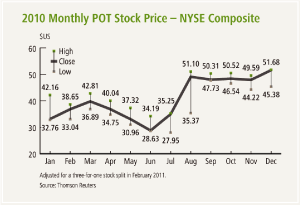
| 2010 Monthly POT Stock Price — NYSE Composite Sus 60 j High fwSe 51.10 50.31 50.52 4959 51‘68 4Z16 42,S1 AnnA / 4"34fi54 40 -j T”‘32341|5y 4"8 30 32.76 33.04 “J/ 28.63 27.95 20 —’ .................... ‘ .............. ‘ .......... ‘ .......... ‘ .......... ‘ ... ‘ .............. ‘ .............. ‘ ............. ‘ ............. ‘ ............. ‘ Jan Feb Mar Apr May Jun Jul Aug Sep Oct Nov Dec Adjusted for a three-for-one stock split in February 2011 Source: Thomson Reuters |
Keyword:Shareholder Info
33
| PotashCorp2010AR.com: Shareholder Info |
| Facebook.com/PotashCorp Find us on Facebook Twitter.com/PotashCorp Follow us on Twitter PotashCorp.com Find us online PotashCorp2010AR.com |


